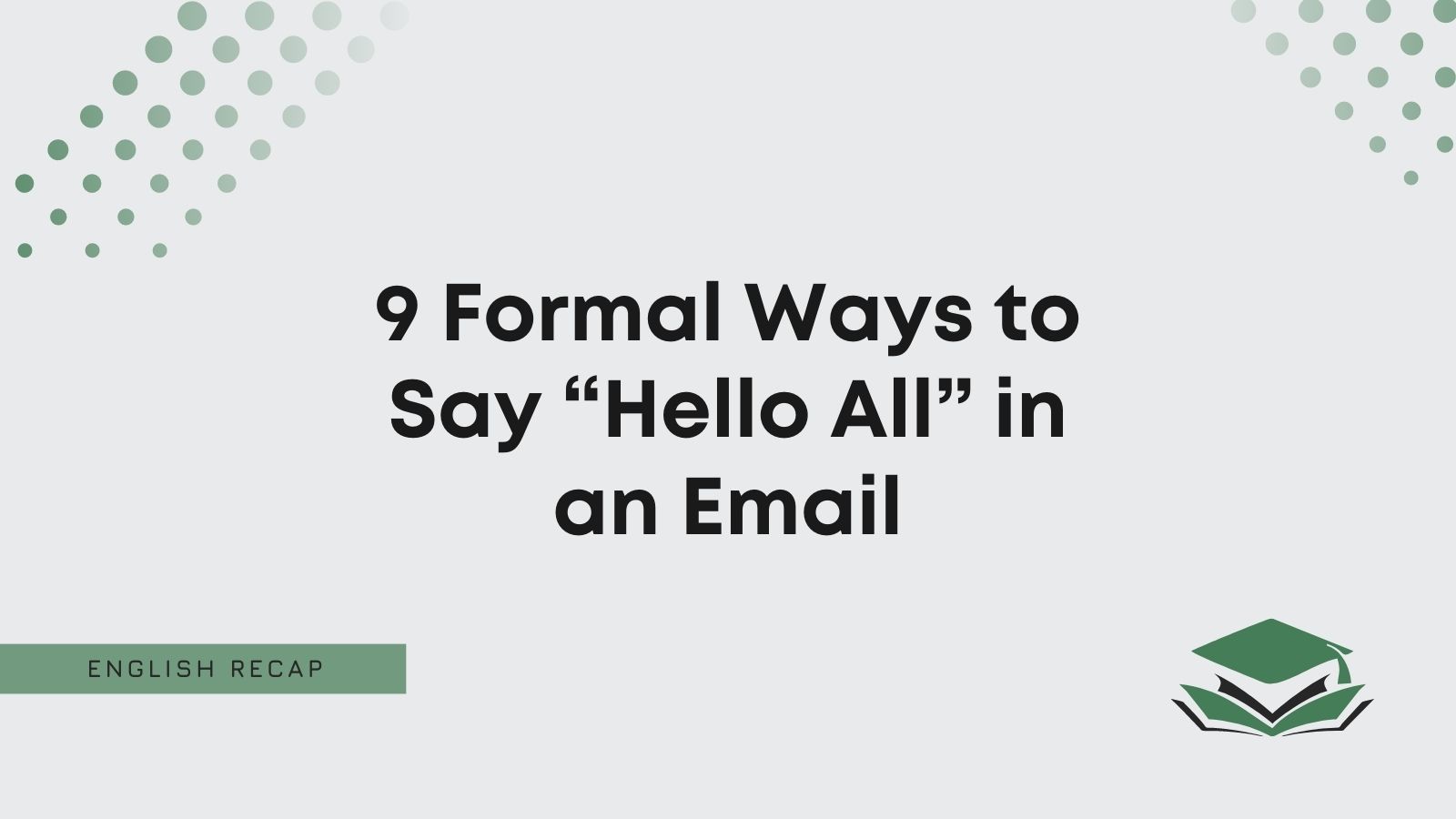It’s important to know the most appropriate way to address a group of people in a formal email. “Hello all” is one option, but is it the most formal one to use?
Luckily, this article has gathered the best phrases to show you different ways to say “hello all.”
Is It Formal to Say “Hello All”?
It is formal to say “hello all” in an email. It works well in all professional emails when addressing a group.
It’s certainly an appropriate term to include in formal writing. You don’t have to specify each individual by their name when addressing a full group.
Also, we consider it a good greeting in most emails. You should include it on the first line when you’re addressing more than one person.
Pros
- It is inclusive and gender-neutral.
- It’s polite and professional.
Cons
- It’s very impersonal.
- You should avoid using it when emailing two people (use names instead).
“Hello all” is certainly one of the most effective phrases to use to open an email. However, it’s not the only choice. It’s wise to have a few others ready to go to mix things up.
Keep reading to learn another way to say “hello all.” We’ve shared some of the best options and provided examples for each one.
What to Say Instead of “Hello All”
- Hi all
- Dear all
- Hello everyone
- Hi everybody
- Dear team
- To all
- Dear colleagues
- Hello
- Good morning/afternoon/evening
1. Hi All
“Hello all” is certainly a great greeting, so you don’t need to change it all that much. You can try “hi all” instead. The only difference is between “hello” and “hi.”
“Hi” sounds much more personal and friendly. So, we recommend using it when addressing a group of employees.
It shows you have a more calm persona as their boss, which might help them to feel more at ease if you’re about to host a team meeting.
If you’re still stuck, check out this email example:
Hi All,
I’m glad that we could meet to discuss these matters on Friday. Now, we should move to the next stage of our development.
Kind regards,
Freya Tiding
2. Dear All
Generally, “hello all” is an impersonal greeting to address multiple people. You can make it slightly more professional by saying “dear all” instead.
It still addresses multiple people, but using “dear” gives off a more impersonal and respectable tone.
We recommend using it if you’re new to a company and want to give off a good (and professional) first impression.
This email sample will also help you:
Dear All,
It’s my pleasure to join the team. I hope you will be happy to hear about some of the exciting ideas I have.
Kind regards,
Ryan Miller
3. Hello Everyone
So far, we’ve changed “hello” to different greetings. However, you can also change “all” to something else to keep your emails fresh and exciting.
“Hello everyone” is a great example of how to say “hello all” in an email. It is professional and welcoming, showing that you want to treat every email recipient equally.
We highly recommend this when setting up team meetings. It’s a great way to address every colleague or employee and try to include them all in the meeting.
This example should help you understand more about it:
Hello Everyone,
Would you please let me know who will be attending the business meeting on Tuesday?
Yours,
Mr. Greetings
4. Hi Everybody
“Hi everybody” is another great alternative to “hello all.” It’s a formal option that allows you to address multiple people in the same email.
We highly recommend it when you want to convey a slightly more friendly tone.
Generally, “hi” is a more friendly synonym than “hello.” That’s why it works better when emailing colleagues or people you have a good working relationship with. It’s wise to keep things civil and friendly with them, after all.
Check out this example if you’re still unsure:
Hi Everybody,
I would like to host an event, and I need all of you to get involved. Please let me know if you’re interested.
Kind regards,
Samson Taylor-Jenkins
5. Dear Team
You can say “dear team” when addressing coworkers in your department. It shows that you value each team member and want to address them as such.
It’s also a good one to use when emailing a team of employees. Therefore, it works well if you’re the boss and want to come across as slightly more inclusive when addressing everyone who works for you.
Check out this email sample to see how it works:
Dear Team,
We are going to hold a meeting on Friday to discuss the changes to the company schedule.
All the best,
Sarah Parker
6. To All
You may find that “to all” is useful in emails and letters. You can use “to” as an opener in both formats, so it’s a great option to say hello to multiple people.
We recommend using this in professional situations, though. It’s quite impersonal, so you won’t have much luck using it when addressing people you have a good relationship with.
Stick to using it with employees. If you’re their boss, you may benefit from the slightly more impersonal language like “to all.”
Here’s a great email example to show you how it works:
To All,
Thank you for helping out with this project. Without your assistance, we would not have made it to the next stage.
Yours,
Benjamin Dickens
7. Dear Colleagues
You can also be more specific about the group you address in an email. For example, “dear colleagues” is clearly a good way to address all your colleagues in an email.
The same rules apply regardless of the address term used. For instance:
- Dear Staff
- Dear Teachers
- Dear Professors
As long as you specify the group, it’s obvious who you’re addressing. It’s a great one to include in most professional emails within the workplace.
This sample email will also help you understand it:
Dear Colleagues,
Thank you for attending the event over the weekend. This is the best turnout we’ve had in a long time.
Yours,
Georgia Adams
8. Hello
You don’t even need to give a specific address like “all” or “everyone.” Removing the address completely and simply using a greeting like “hello” works well.
“Hello” in itself is an indirect way to address one or multiple people. Therefore, it’s a great introduction to a bulk email suggesting you’re talking to many people simultaneously.
We highly recommend it to sound formal and polite when addressing a group you’re not very familiar with. It might suggest that you don’t know their names and don’t know what to call them as a group.
You can also review the following example:
Hello,
I hope you are all keeping well. I have arranged a meeting for us all on Tuesday 16th. Let me know if this works for you.
Kind regards,
Adam Toni
9. Good Morning/Afternoon/Evening
Finally, it’s worth exploring the time at which you send an email. That’s why “good morning/afternoon/evening” are all appropriate to include in a formal email.
Of course, the time of day is important here. You should only use the appropriate time based on when you send the email.
Keep in mind that it doesn’t matter when someone reads the email (i.e., if they read your “good morning” email in the evening).
We recommend using this to address a group of employees. It’s a good way to stay friendly with them without getting too personal or informal.
Perhaps these email examples will also help you:
Good Morning,
I would like to invite you all to join me for a business lunch this weekend. Please let me know if you can attend.
Best wishes,
Joseph Carling
Good Afternoon,
I hope this email finds you well. Do you have any notes that would benefit me from the meeting?
Kind regards,
Peter Andreas

